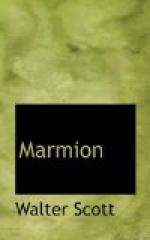’Along the woods,
along the moorish fens,
Sighs the sad
genius of the coming storm;
And up among the
loose disjointed cliffs,
And fractured
mountains wild, the brawling brook
And cave, presageful,
send a hollow moan,
Resounding long
in listening fancy’s ear.’
line 204. ’At one corner of the burial-ground of the demolished chapel, but without its precincts, is a small mound, called Binrams Corse, where tradition deposits the remains of a necromantic priest, the former tenant of the chaplainry. His story much resembles that of Ambrosio in “The Monk,” and has been made the theme of a ballad by my friend Mr. James Hogg, more poetically designed the Ettrick Shepherd. To his volume, entitled “The Mountain Bard,” which contains this, and many other legendary stories and ballads of great merit, I refer the curious reader.’—Scott.
line 239. ’Loch-skene is a mountain lake, of considerable size, at the head of the Moffat-water. The character of the scenery is uncommonly savage; and the earn, or Scottish eagle, has, for many ages, built its nest yearly upon an islet in the lake. Loch-skene discharges itself into a brook, which, after a short and precipitate course, falls from a cataract of immense height and gloomy grandeur, called, from its appearance, the “Grey Mare’s Tail.” The “Giant’s Grave,” afterwards mentioned, is a sort of trench, which bears that name, a little way from the foot of the cataract. It has the appearance of a battery designed to command the pass.’—Scott.
Cp. ‘Loch Skene,’ a descriptive and meditative poem by Thomas Tod Stoddart, well known as poet and angler on the Borders during the third quarter of the nineteenth century:—
’Like a pillar
of Parian stone,
That in some old
temple shone,
Or a slender shaft
of living star,
Gleams that foam-fall
from afar;
But the column
is melted down below
Into a gulf of
seething snow,
And the stream
steals away from its whirl of hoar,
As bright and
as lovely as before.’
CANTO SECOND.
lines 1-6. The earlier editions have a period at the end of line 5, and neither Scott himself nor Lockhart changed that punctuation. But, undoubtedly, the first sentence ends with line 11, ‘roll’d’ in the second line being a part, and not a finite verb. Mr. Rolfe is the first to punctuate the passage thus.
line 9. ’The Abbey of Whitby, in the Archdeaconry of Cleaveland, on the coast of Yorkshire, was founded A. D. 657, in consequence of a vow of Oswy, King of Northumberland. It contained both monks and nuns of the Benedictine order; but, contrary to what was usual in such establishments, the abbess was superior to the abbot. The monastery was afterwards mined by the Danes, and rebuilded by William Percy, in the reign of the Conqueror. There were no nuns there in Henry the Eighth’s time, nor long before it. The ruins of Whitby Abbey are very magnificent.’—Scott.




